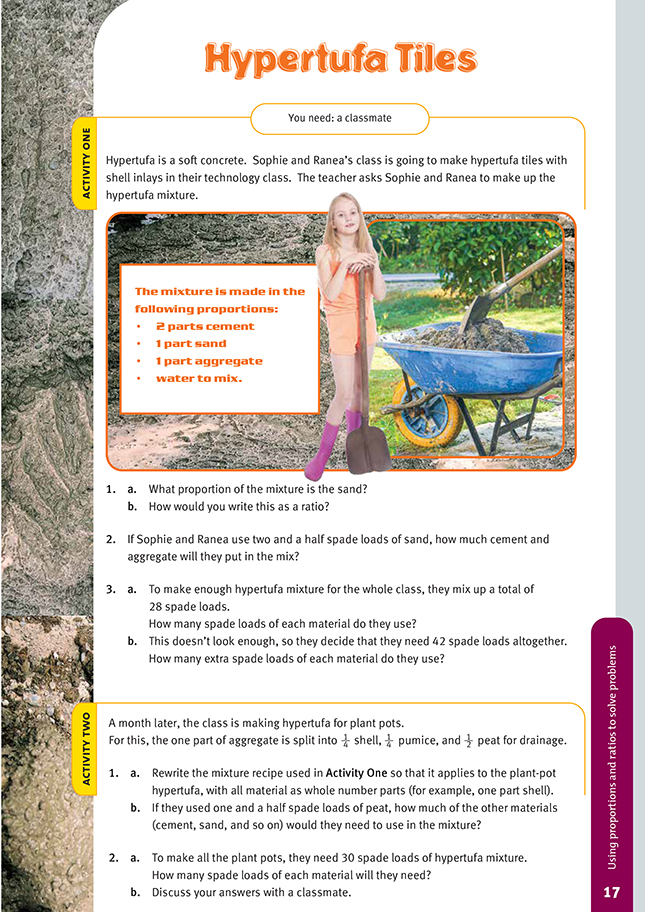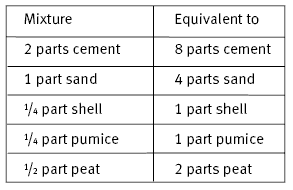This is a level 4 number activity from the Figure It Out series. It relates to Stage 7 of the Number Framework.
A PDF of the student activity is included.
Click on the image to enlarge it. Click again to close. Download PDF (309 KB)
solve problems involving linear proportions
FIO, Level 4+, Number, Book Six, Hypertufa Tiles, page 17
A classmate
Ratios and proportions can be a bit confusing, and this activity helps address confusions that arise about these maths ideas.
In Activity One, the students need to recognise that the mixture contains four parts in total and that just one of these is sand. The sand therefore accounts for one-quarter or 25% of the parts. However, in terms of ratios, the mixture comprises one part sand to three parts of other ingredients (cement and aggregate) so that sand as a ratio is written 1:3. Proportion then has to do with comparison to the total, whereas ratio has to do with comparison to the other constituent parts. To illustrate this further, concrete can be made from one part cement and four parts builders’ mix. This means that the proportion of cement is 1 out of 5 or 20%, whereas the ratio is 1:4.
For the remainder of the problems in Activity One and for those in Activity Two, the students will be working with the idea of proportion, including its application to fractions. In Activity One, question 2, for example, they need to reason that if 21/2 spade loads of sand represents one part of the mixture, then you need 21/2
spade loads of aggregate and twice that of cement (that is, five spade loads). In question 3a of this activity, they need to reason backwards: if a quantity of 28 spade loads is mixed, then one-quarter (seven spade loads) will be sand, the same will be aggregate, and half (14 spade loads) will be cement. The students need to note that in question 3b they are required to work out how many extra spade loads of each ingredient are required. They may be surprised to find that they are getting into fractions with this question. That is, with 14 extra spade loads needed, half (seven spade loads) will obviously be cement, but the one-quarter each of sand and aggregate both work out at 31/2 spade loads.
Activity Two is a nice extension on question 3a and has the students using a fraction (that is, one-quarter shell, and so on) as the base unit of 1. Students who have difficulty with this problem may find it useful to rewrite the mixture, perhaps as follows:
Answers to Activities
Activity One
1. a. 1/4. (This can be written as 25%.)
b. 1:3
2. 5 spade loads of cement
2 1/2 spade loads of aggregate
3. a. 14 spade loads of cement
7 spade loads of sand
7 spade loads of aggregate
b. 7 spade loads of cement and 3 1/2 each of sand
and aggregate.
Activity Two
1. a. 8 parts cement
4 parts sand
1 part shell
1 part pumice
2 parts peat
water to mix
b. 6 spade loads cement
3 spade loads sand
3/4 spade load shell
3/4 spade load pumice
2. a. 15 spade loads cement
7 1/2 spade loads sand
1 7/8 spade loads shell
1 7/8 spade loads pumice
3 3/4 spade loads peat
b. These quantities would not be easily measured, so they would probably decide to make more than they actually needed, to keep the proportions as accurate as possible. The nearest easily measured mixture would be these spade loads: 16 of cement, 8 of sand, 2 of shell, 2 of pumice, and 4 of peat.

